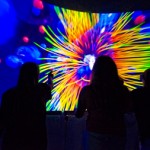Top three Star Trek-style holodeck experiences

Surround 3D TV is making its way to your living room. To get a sense of what it may look and sound like, look no further than the cutting edge of virtual reality taking shape at academic research centers outfitted with world class data visualization facilities. In this post, we'll take a look at three (ok, four) of the most remarkable scientific visualization technologies.
Allosphere: University of California, Santa Barbara

The facility consists of a 30-foot diameter sphere built inside a 3-story cube that's nearly echo-free. Inside the chamber are two spherical hemispheres that are constructed of perforated aluminum designed to be optically opaque and acoustically transparent. A 7-foot-wide bridge runs across the center, supporting the users. High-resolution video projectors can project images across the entire inner surface enabling seamless stereo-optic 3D projection.
The Allosphere has more than 500 audio components that hang suspended in rings just outside the aluminum shell and are connected to multiple Gigabit Ethernet LAN fibers that lead to a server farm consisting of seven Hewlett Packard 9400 workstations (as of April 2009).
"The result is something far beyond other virtual reality systems such as a Cave Automatic Virtual Environment (CAVE) [to be covered next in this post] or a planetarium: 360 degrees of sounds and images in a chamber large enough to hold 30 or more researchers at once," writes Scientific American.
It's a place where you can use all of your senses to find new patterns in data, according to JoAnn Kuchera-Morin, the AlloSphere's director. "You can almost say researchers are shrunk down to the size of their data, immersed at a perceptual level."
The AlloSphere was physically completed in February of 2007.
Resolution: 24 million pixels
Number of projectors: 14
Total lumens: 42,000
Sound system: 512 individual speaker elements (i.e. tweeters, woofers) plus subwoofer
Further reading: The Allosphere Research Facility, Scientific American
Next »
StarCAVE and NexCAVE: University of California, San Diego
Groups of researchers at UC San Diego venture into worlds as small as nanoparticles and as large as the cosmos. One timely application displays computer-aided design models of parts of the new San Francisco Oakland Bay Bridge that allows users to walk/fly through these parts at their real size, to find material clashes and construction errors.
StarCAVE's audio system consists of a 15 surround sound speakers plus subwoofer using wave field synthesis (technology that maximizes the perception of many channels of sound emanating from different sides of the room). User interaction is provided via a wand and multi-camera, wireless tracking system. The StarCAVE offers 20/40 vision in a fully horizontally enclosed space with a diameter of 3 m and height of 3.5 m. The best part may be the price: It cost under $1 million.
StarCAVE is the third generation of surround-VR rooms. (The original VR room--named Cave Automated Virtual Environment, or CAVE was built at the University of Illinois at Chicago's Electronic Visualization Lab (EVL) in 1999. Ten years later, a second-generation model was built at EVL.)
The current StarCAVE system provides an improved 3-D experience by allowing viewers to wear only lightweight, polarized 'sun' glasses.
Resolution: 68 million pixels
Number of projectors: 34 (2 per screen)
Total lumens: 27,200 (800 per projector)
Sound system: Three arrays of five conventional high-quality speakers to provide 5.1 surround sound or up to 15 channels of discreet audio diffusion (with a subwoofer channel built into the floor structure)
Recognizing that projectors are on their way out, and flat panel screens on the way in, last summer UCSD researchers at the California Institute for Telecommunications and Information Technology (Calit2) designed a 9-panel, 3-D visualization display made from flat-panel LCD screens and called the new technology NexCAVE.
NexCAVE allows users to visualize massive data-sets in stereo at unprecedented speeds without the maintenance woes caused by StarCave's projectors. Additionally, the bright HDTVs are bright enough to leave the lights on, which was not a possibility with the StarCAVE.
"The NexCAVE brings LCD panel tiled displays into the domain of 3D virtual reality, making tens-of-megapixel immersive viewing available for the first time in an office/laboratory-sized footprint," said Calit2 Research Scientist Tom DeFanti, who led the effort to design and develop the NexCAVE.
"The cost of the NexCAVE is a fraction of VR projection systems (like Calit2's StarCAVE), an added bonus, and it is 100% compatible with our application-enabling visualization software."
"Our next goal is to make an autostereo NexCAVE," says DeFanti (meaning the screens won't require the use of special glasses). "And someday we hope to have organic LED screens with no bezels."
Further reading: UC San Diego News Center, California Institute for Telecommunications and Information Technology, National Science Foundation, Gizmodo
Next »
CORNEA: King Abdullah University of Science and Technology (KAUST), Saudi Arabia
It offers realistic spatial surround audio, which is illustrated in this re-creation (video) of an archaeological excavation site in Jordan.
CORNEA is based on technology used in UCSD's CAVE but uses updated audio system designed by Calit2 and constructed for KAUST by Mechdyne and Meyer Sound. It uses 24 4K projectors, with native resolution of 4,096 x 2,160 pixels each (roughly four times the resolution of HDTV). The spatial-surround sound audio system makes it possible to play multi-channel audio and add directional sound cues to visual images mimicking reality like no other system.
Here are the mind-blowing tech specs that allow for a system with bragging rights as the world's highest resolution and brightest virtual lab:
- 96 quad-core CPUs
- 768 gigabytes of RAM
- 12 TB of internal hard drive capacity
- Dual gigabit interprocessor connectivity
- 2 x 10 gigabit uplinks
- 96 FX5600 GPUs
- 144 GB of graphics memory
- 48 TB of external storage
Resolution: 100 million pixels
Number of projectors: 24
Total lumens: 240,000 (10,000 per projector)
Sound system: Custom design from Calit2 with Meyer's Constellation Electroacoustic Architecture (details unavailable)